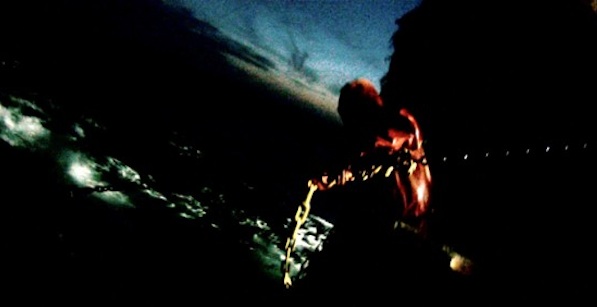I’ve never found myself so reluctant to write an introductory text to a video as now. I don’t know whether it’s because I have so many things to say about Leviathan that the very thought of sitting down to write them out is exhausting in itself. Thoughts related to the relationship between observational documentary, experimental cinema and lo-fi horror movie tricks, New England nautical lore and Moby Dick; upside-down seagulls and whether a child would connect all those disemboweled sea creatures floating in the ocean to images of Spongebob Squarepants (I did); industrialized food production and The Deadliest Catch; alienated labor vs. alienated film viewing (or, these days, film viewing AS alienated labor); the false promises of GoPro cameras and the subversive glories of the HD amateur aesthetic; how sound designer Ernst Karel might be the real artist that holds this squishy contraption of a film together, but of course when it comes to cinema the eye always trumps the ear (that is, how we recognize it, not how we actually experience it); buzzwords like Sensory Ethnography that magically marry the seemingly unrelated worlds of visual anthropology and international film festivals; and how such a visually radical film can have such an affected Goth title design (supposedly they got the idea for the font because the fishermen loved to listen to death metal), which suggests that the makers either take themselves too seriously or not seriously at all. Indeed, the film occupies vertiginous extremes with equal parts exasperation and bravery. Such qualities are required of the viewer in facing this film.
And yet, however many thoughts pass by, there’s the overriding thought that the task of amassing them somehow threatens something essential about why Leviathan matters: the need to let it speak for itself, without pre-conceptions, context or user manuals. And yet, the pressing question that Leviathan asks us is “How to watch this?” a question to which it offers many hints (of which I listed the first that came to mind above), but never answers squarely.
And so I rather sheepishly offer this video that both does too much and not enough. Not enough, in that I offer but five textual frameworks for approaching the film out of numerous options. Too much, in that these texts may inherently be a counter-productive imposition on the material, suppressing untold potentials for comprehension. But we have to start somewhere. It’s the hope that with these five we can watch and listen to a dialogue take place: one between the film and a handful a ways that it might be understood, in terms of its associations with classic literature (Melville), production technology and pro-sumer culture (GoPro), American economy and the fishing industry (New Bedford), stated artistic intention (Verena Paravel), and critical reception (Phil Coldiron/Cinema Scope). How do they line up, and how do they separate? Nothing is certain. With this film, meaning is found only through casting one’s nets in a swirling tempest.
Kevin B. Lee is a filmmaker, critic, video essayist, and founding editor of Keyframe. He tweets as @alsolikelife.




